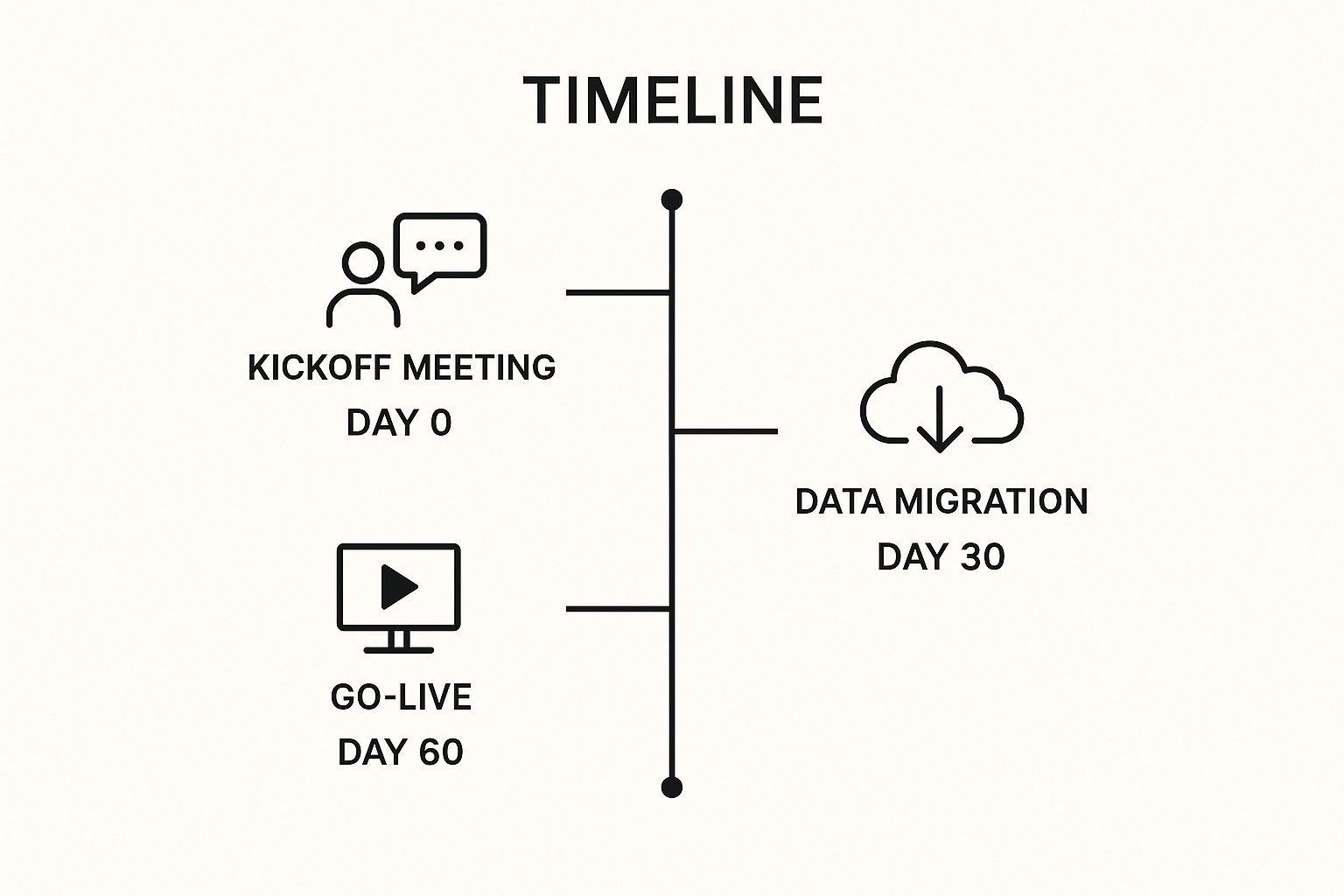The sales team closes the deal, but the real work begins now. A haphazard welcome can quickly sour a promising partnership, leading to confusion, frustration, and early churn. Conversely, a masterful client onboarding process sets the stage for long-term loyalty and success, transforming a new customer into a confident, empowered partner ready to achieve their goals. This is where you secure the future value of the relationship.
This guide moves beyond generic advice to provide a strategic blueprint for retention and growth. We will explore ten actionable client onboarding best practices, tailored specifically for professional services and B2B firms. Each point is designed to help you create a seamless, value-driven experience from day one and build a foundation for a successful, long-term collaboration.
You will learn how to structure a proactive and personalized welcome that immediately demonstrates your value and competence. These aren't just steps in a checklist; they are strategic investments in the lifetime value of your clients. By implementing these proven strategies, you can reduce churn, increase customer satisfaction, and turn new clients into your most vocal advocates. Let's get started.
1. Pre-boarding Preparation and Planning
Effective client onboarding doesn’t start on day one; it begins the moment the contract is signed. Pre-boarding is the proactive, systematic process of gathering all necessary information, documents, and assets before the official kickoff. This critical phase transforms the transition from sales to service into a seamless, organized experience, preventing the chaotic scramble for details that often derails new partnerships.

This practice, popularized by consulting giants like McKinsey & Company and Accenture, involves creating comprehensive client profiles, configuring internal systems, and preparing all materials in advance. For example, HubSpot uses automated pre-onboarding questionnaires to collect client goals and technical requirements, ensuring their team arrives at the first meeting fully prepared. Similarly, Salesforce conducts detailed discovery sessions to map a client’s specific needs to their platform’s capabilities, setting the stage for a tailored implementation.
Why This Practice Is Essential
The pre-boarding phase is your first opportunity to demonstrate competence and organization, building immediate trust. By gathering data upfront, you eliminate delays, clarify scope, and ensure your team can deliver value from the very first interaction. This is a core component of successful client onboarding best practices because it lays the foundation for a successful, long-term relationship built on clarity and efficiency.
Actionable Implementation Tips
- Develop Standardized Checklists: Create detailed, role-specific checklists for different client types or service tiers. This ensures consistency and prevents crucial steps from being missed.
- Utilize Automation: Employ forms, client portals, or CRM workflows to automate the collection and organization of client information, such as contact details, project requirements, and necessary credentials.
- Set Clear Expectations: Provide your new client with a clear timeline and a list of all the information they need to provide. This empowers them to participate effectively and shows respect for their time.
2. Welcome Kit and First Impression Management
The first official interaction sets the tone for the entire client relationship. A thoughtfully crafted welcome experience, centered around a physical or digital welcome kit, immediately validates the client's decision and demonstrates your commitment. This goes beyond a simple "thank you" email; it's a strategic package of resources, information, and branded materials designed to make the client feel valued and prepared for the journey ahead.

This principle is borrowed from world-class hospitality and retail brands like Ritz-Carlton and Apple, which excel at creating memorable initial experiences. In the B2B world, companies like Mailchimp execute this brilliantly with a step-by-step welcome email series that provides actionable tips and templates. Similarly, Adobe provides comprehensive onboarding kits with video tutorials and resource libraries, empowering users to find immediate value. These actions build excitement and reduce initial friction.
Why This Practice Is Essential
A strong first impression builds emotional buy-in and reinforces the client's confidence in their choice. By providing a welcome kit, you equip them with everything they need to get started, answer common initial questions, and introduce key team members. This proactive approach is a cornerstone of client onboarding best practices because it transforms a transactional start into a relationship-focused welcome, fostering goodwill and setting a positive precedent.
Actionable Implementation Tips
- Personalize Welcome Materials: Go beyond generic templates. Include the client's name, company logo, and reference specific goals discussed during the sales process to show you were listening.
- Clarify Immediate Next Steps: Include a clear, concise "What to Expect Next" guide or a project timeline. This manages expectations and provides a clear roadmap for the initial weeks.
- Use Multiple Formats: Cater to different learning preferences by including a mix of content like a welcome video from your CEO, a printed getting-started guide, and links to a digital resource hub.
- Include Social Proof: Add a short case study or testimonial from a similar client. This reinforces their decision and shows them what success looks like.
3. Dedicated Onboarding Team Assignment
Transitioning a client from a signed contract to an active, successful partner requires specialized skills. Assigning a dedicated onboarding team means having specialists who focus exclusively on guiding new clients through the critical initial phase. These experts are masters of the first 90 days, equipped with refined processes to manage expectations, accelerate time-to-value, and navigate common early-stage challenges with precision.
This model was championed by the customer success movement, led by thought leaders like Lincoln Murphy and companies such as Gainsight. Real-world examples include Zendesk, which uses dedicated onboarding specialists within its Customer Success team to ensure new users are proficient and engaged. Similarly, Shopify’s Partner Success team provides focused support for new merchants, helping them overcome initial hurdles and find success on the platform, which in turn fosters long-term loyalty.
Why This Practice Is Essential
A dedicated onboarding team ensures consistency, expertise, and a superior client experience. Instead of an account manager juggling sales, support, and onboarding, a specialist provides focused, expert guidance. This approach dramatically reduces the risk of early churn by ensuring clients achieve their first "win" quickly. It is one of the most effective client onboarding best practices for B2B and SaaS companies because it professionalizes the transition and directly links initial engagement to long-term retention.
Actionable Implementation Tips
- Invest in Specialized Training: Equip your onboarding team with deep product knowledge, project management skills, and training on client communication protocols.
- Define a Clear Handoff Process: Create a structured handoff from the onboarding specialist to the long-term account manager or customer success manager. This ensures a seamless transition without losing client context.
- Establish Onboarding-Specific Metrics: Track key performance indicators (KPIs) like time-to-first-value, product adoption rates, and initial client satisfaction scores to measure the team’s effectiveness.
4. Clear Timeline and Milestone Communication
Clarity is the cornerstone of client confidence. Establishing and communicating a detailed timeline with specific milestones from day one eliminates ambiguity and manages expectations effectively. This practice involves creating a transparent roadmap that outlines every phase of the onboarding process, from the initial kickoff to full implementation, ensuring both parties are perfectly aligned on deliverables, responsibilities, and deadlines.
This approach, deeply rooted in the principles of project management frameworks like Agile and Scrum, transforms onboarding from a vague process into a structured, predictable journey. For example, project management software company Asana provides clients with interactive project timelines where they can track progress and see upcoming deadlines in real-time. Similarly, enterprise software firm Workday delivers detailed, multi-phase implementation roadmaps, giving clients a clear picture of the entire project scope and key checkpoints along the way.
The following infographic illustrates a simplified yet effective onboarding timeline, highlighting critical milestones that provide structure and measure progress.

This visual representation breaks down a complex process into manageable stages, providing clear markers of success and keeping the project on track.
Why This Practice Is Essential
A transparent timeline serves as a powerful tool for building trust and preventing scope creep. When clients can see the path forward and understand their role in it, they feel more secure and involved in the partnership. This proactive communication is a vital component of client onboarding best practices because it minimizes surprises, reduces client anxiety, and demonstrates a commitment to an organized, goal-oriented process that respects the client’s investment and time.
Actionable Implementation Tips
- Utilize Project Management Tools: Employ tools like Asana, Trello, or Basecamp to create shared, visual timelines. This allows both your team and the client to track progress, comment on tasks, and stay updated in real-time.
- Build in Buffer Time: Account for potential roadblocks or unexpected delays by adding a buffer to your deadlines. This creates a more realistic schedule and prevents the stress of constantly pushing back dates.
- Celebrate Milestones: Acknowledge and celebrate the completion of key milestones with your client. This reinforces progress, boosts morale, and strengthens the collaborative relationship.
5. Progressive Training and Education Programs
Effective onboarding isn’t about overwhelming clients with a tidal wave of information on day one. It’s about empowerment through structured learning. Progressive training is a phased educational approach that delivers information in digestible modules, building a client’s competency and confidence over time. Instead of a one-time data dump, this method aligns learning with the client’s actual journey, providing the right information at the right time.
This practice is championed by customer education leaders who understand adult learning principles. For example, Salesforce Trailhead breaks down complex platform knowledge into bite-sized modules and guided learning paths, allowing users to learn at their own pace. Similarly, HubSpot Academy offers certifications that progress from foundational concepts to advanced strategies, ensuring users master one area before moving to the next. This prevents overwhelm and boosts long-term adoption.
Why This Practice Is Essential
A client who feels confident using your product or service is a client who will achieve their desired outcomes and remain a loyal partner. Progressive training transforms the learning curve from a steep, intimidating obstacle into a manageable and rewarding journey. This is one of the most crucial client onboarding best practices for complex B2B solutions, as it directly impacts user adoption, perceived value, and ultimately, customer lifetime value.
Actionable Implementation Tips
- Align Training with Usage Patterns: Map out the typical client journey and structure your training modules to coincide with key milestones and feature adoption stages. The initial phase might cover basic setup, while later phases introduce advanced functionalities.
- Offer Multi-Format Learning: Cater to different learning styles by providing a mix of resources, such as short video tutorials, interactive webinars, hands-on practice environments, and detailed knowledge base articles.
- Track Engagement and Gather Feedback: Use learning management systems or platform analytics to monitor which resources clients are using. Actively solicit feedback to refine and improve your educational content continuously.
6. Data Migration and System Integration Support
For many clients, particularly in the B2B SaaS and technology sectors, the biggest onboarding hurdle is technical. Data migration and system integration support involves actively assisting clients in transferring their historical data from old systems and ensuring your solution seamlessly integrates with their existing technology stack. This hands-on approach minimizes disruption and tackles the technical barriers that frequently cause onboarding failures or significant delays.
This practice is a cornerstone for enterprise software vendors and systems integration consultants. For instance, Salesforce provides robust tools like the Data Import Wizard and dedicated professional services to manage complex data transfers. Similarly, Microsoft offers a suite of migration tools to help businesses transition to Office 365, while Workday employs a structured data conversion methodology for large-scale HR implementations. These services ensure that the client's crucial business data is preserved and functional within the new environment.
Why This Practice Is Essential
Poor data migration can cripple a client's operations and completely derail their perceived value of your product or service. By providing expert support, you ensure business continuity, reduce client-side stress, and accelerate their time-to-value. This is a critical component of modern client onboarding best practices because it demonstrates a deep commitment to the client's operational success beyond just the initial sale, cementing your role as a true partner.
Actionable Implementation Tips
- Conduct a Pre-Migration Data Audit: Before any transfer begins, analyze the client’s existing data for quality, completeness, and structure. This helps identify potential issues early.
- Provide Clear Formatting Guidelines: Give clients a detailed template or guide on how their data needs to be formatted for a successful import. This minimizes errors and back-and-forth communication.
- Use a Sandbox Environment for Testing: Always perform a test migration in a non-production, or sandbox, environment. This allows you to resolve any problems without affecting the client’s live operations. To see this in action, you can explore this detailed Salesforce implementation guide.
7. Regular Check-ins and Feedback Loops
Onboarding is not a one-time event but a continuous journey. Establishing systematic check-ins and feedback loops ensures you remain aligned with your client, address concerns proactively, and demonstrate an ongoing commitment to their success. This practice involves creating planned touchpoints to assess progress, gather insights, and make necessary adjustments before minor issues escalate into major problems.

This methodology is a cornerstone of modern customer success and agile frameworks. For example, Zoom schedules weekly check-ins with enterprise clients during their initial setup to ensure smooth adoption. Similarly, Adobe integrates milestone reviews with automated feedback surveys into its onboarding process, allowing them to measure satisfaction and pinpoint areas for improvement in real time. ServiceNow also employs structured implementation reviews at key stages, keeping the project on track and aligned with client expectations.
Why This Practice Is Essential
Regular communication transforms the client relationship from a transactional service into a collaborative partnership. By actively seeking feedback, you show that you value your client's perspective and are invested in their outcomes. This iterative approach is one of the most effective client onboarding best practices because it builds trust, mitigates risk, and fine-tunes your service delivery for maximum impact. Consistent feedback loops are a powerful driver for long-term loyalty and can significantly boost customer retention rates.
Actionable Implementation Tips
- Schedule Check-ins at Milestones: Plan your touchpoints around natural project milestones, such as after the kickoff meeting, post-training, or upon initial setup completion. This makes the check-ins relevant and timely.
- Use a Mix of Communication Channels: Combine formal, scheduled meetings with informal touchpoints like a quick email or a message via your shared communication channel. This maintains momentum without creating meeting fatigue.
- Create Standardized Feedback Templates: Develop simple, standardized surveys or question sets to gather consistent feedback. Ask targeted questions about communication, progress, and overall satisfaction.
- Share Insights Internally: Ensure the feedback collected is shared across the entire onboarding team. This fosters a culture of continuous improvement and allows everyone to learn from client experiences.
8. Customization and Personalization Approach
A one-size-fits-all onboarding process rarely delivers exceptional results. A customization and personalization approach tailors the onboarding experience to each client's unique industry, size, goals, and technical skill level. This client-centric method moves beyond a rigid, standardized script to create a journey that directly addresses their specific needs and circumstances, making them feel understood and valued from the start.
This strategy is a cornerstone for customer experience leaders and enterprise software giants. For instance, Tableau provides role-based onboarding paths for different user types, such as data analysts versus business executives, ensuring each receives relevant training. Similarly, Slack offers department-focused setup guides for teams like marketing or engineering, helping them integrate the tool into their specific workflows immediately. This level of personalization ensures faster adoption and higher satisfaction.
Why This Practice Is Essential
Personalizing the onboarding journey demonstrates that you have listened to your client's needs and are invested in their specific success, not just closing a deal. It accelerates their time-to-value by focusing only on the features and processes relevant to their goals, which reduces confusion and boosts engagement. This focus on relevance is one of the most impactful client onboarding best practices for building loyalty and preventing early-stage churn.
Actionable Implementation Tips
- Create Client Personas: Develop detailed personas for your typical client segments based on industry, company size, and user roles. Use these personas to pre-define customized onboarding paths.
- Develop Modular Content: Build your onboarding materials (guides, videos, checklists) as individual modules that can be easily mixed and matched to create a personalized curriculum for each new client.
- Leverage Intake Information: Use data collected during the pre-boarding phase, such as from questionnaires or discovery calls, to automatically assign the appropriate onboarding track and materials.
9. Success Metrics Definition and Tracking
Defining what success looks like is fundamental to achieving it. This practice moves beyond assumptions by establishing clear, mutually agreed-upon metrics to measure the effectiveness of the onboarding process. It involves defining key performance indicators (KPIs), implementing robust tracking systems, and using that data to prove value and continuously refine your approach. This isn’t just about internal reporting; it’s about creating a transparent scorecard for the client partnership.
This methodology was championed by the SaaS industry and data-driven management consultants who needed to quantify client progress and ROI. Customer success platforms like Gainsight and ChurnZero built their models around this, using onboarding milestone tracking and predictive "health scores" to identify at-risk accounts. For instance, ChurnZero’s analytics can flag a client who hasn't adopted a key feature by week two, allowing for proactive intervention before dissatisfaction sets in.
Why This Practice Is Essential
Without defined success metrics, onboarding is just a series of activities with no clear destination. This practice transforms the process into a goal-oriented journey, providing tangible proof of progress and value delivered. It’s a core component of modern client onboarding best practices because it aligns both parties on what a successful outcome is, holding your team accountable and demonstrating ROI to the client from the start.
Actionable Implementation Tips
- Balance Leading and Lagging Indicators: Track both outcome-focused metrics (e.g., churn rate, renewal rate) and forward-looking activity metrics (e.g., feature adoption, training completion, time-to-first-value).
- Include Both Quantitative and Qualitative Metrics: Combine hard data like usage statistics with qualitative feedback from client satisfaction surveys (e.g., CSAT, NPS) to get a complete picture. Learn more about how to measure customer experience on twelverays.agency to build a holistic view.
- Share Progress with Clients: Create a shared dashboard or include key metrics in your regular progress reports. This transparency builds trust and keeps everyone focused on the defined goals.
10-Key Client Onboarding Practices Comparison
From Onboarding to Ongoing Partnership
Transitioning from a promising sales conversation to a successful, long-term partnership hinges on the quality of your client onboarding. As we've explored, this critical phase is far more than a procedural checklist; it's the foundational act of building trust, demonstrating value, and setting the stage for mutual success. Simply getting a client "set up" is a missed opportunity. The true goal is to integrate them so seamlessly and effectively that they cannot imagine achieving their goals without you.
Implementing a structured yet flexible approach is paramount. By weaving together the ten client onboarding best practices discussed in this article, you create a powerful, repeatable system that minimizes friction and maximizes early wins. From the meticulous pre-boarding preparation and the impactful welcome kit to the crucial definition of success metrics, each step is a deliberate investment in the client relationship. This isn't just about good customer service; it's a strategic imperative for retention and growth.
Key Takeaways for a Superior Onboarding Experience
Let's distill the core principles into actionable takeaways:
- Proactivity Over Reactivity: The best onboarding programs anticipate client needs. This means having a dedicated team, a clear timeline, and a plan for data migration before the client has to ask.
- Communication is the Cornerstone: Consistent, clear communication through regular check-ins and established feedback loops prevents misunderstandings and demonstrates your commitment. It transforms a service delivery into a collaborative journey.
- Empowerment Drives Adoption: Progressive training and personalized support are not just about teaching someone how to use a tool or service. They are about empowering the client to become a self-sufficient, expert user who extracts maximum value from your offering.
- Success Must Be Measured: Without mutually agreed-upon success metrics, "success" is subjective and difficult to prove. Defining and tracking these metrics from day one provides a clear benchmark for evaluating progress and demonstrating your impact.
Ultimately, mastering these client onboarding best practices creates a powerful ripple effect across your entire organization. It reduces churn by solidifying client commitment early, generates more positive reviews and referrals, and frees up your support teams from handling preventable issues. You stop treating onboarding as a cost center and start leveraging it as a profit-driving engine for sustainable, long-term partnerships. The initial investment of time and resources pays dividends in client loyalty and advocacy, turning new customers into your most effective brand champions. A well-executed onboarding isn't the end of the sales process; it's the beginning of a lasting, profitable relationship.
Ready to transform your client relationships from the very first interaction? At Twelverays, we specialize in implementing robust CRM and marketing automation systems that power exceptional onboarding experiences. Let's build a seamless, scalable process that turns your new clients into lifelong partners. Learn more at Twelverays.





